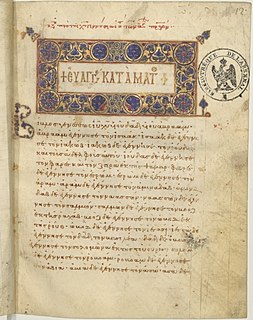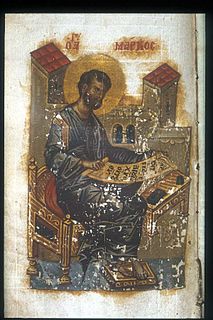Related Research Articles
Minuscule 7, ε 287, is a Greek minuscule manuscript of the New Testament, on parchment. Palaeographically it has been assigned to the 12th century.
Minuscule 19 (in the Gregory-Aland numbering), A214 (Von Soden). It is a Greek minuscule manuscript of the New Testament, on 387 parchment leaves, dated palaeographically to the 12th-century. It has complex contents and marginalia.
Minuscule 24 (in the Gregory-Aland numbering), A18 (von Soden). It is a Greek minuscule manuscript of the New Testament, written on vellum. Palaeographically it has been assigned to the 10th-century. It has marginalia.
Minuscule 25 (in the Gregory-Aland numbering), A139 (Soden). It is a Greek minuscule manuscript of the New Testament, written on vellum, on parchment leaves. Palaeographically it has been assigned to the 11th-century. It has marginalia (incomplete) and was adapted for liturgical use.
Minuscule 40 (in the Gregory-Aland numbering), A155 (Von Soden) is a Greek minuscule manuscript of the New Testament. Paleographically it has been assigned to the 11th century. It is written on vellum and has marginalia.

Minuscule 43, α 270 and ε 170, is a Greek minuscule manuscript of the New Testament, on parchment leaves. Palaeographically it has been assigned to the 11th century. Gregory suggested the 12th century. It has full marginalia.

Minuscule 45, ε 442, is a Greek minuscule manuscript of the New Testament, on parchment leaves. Palaeographically it has been assigned to the 13th century. It has complex contents and full marginalia.

Minuscule 46, ε 1285, is a Greek minuscule manuscript of the New Testament, on parchment leaves. Paleographically it has been assigned to the 13th century. It has complex contents and full marginalia.
Minuscule 48 (in the Gregory-Aland numbering), A232 (von Soden), is a Greek minuscule manuscript of the New Testament, on parchment leaves. Palaeographically it has been assigned to the 12th century. It has complex contents with some marginalia.
Minuscule 49, ε 155, is a Greek minuscule manuscript of the New Testament, on parchment leaves. Paleographically it has been assigned to the 12th century. It has complex contents and full marginalia.
Minuscule 50 (in the Gregory-Aland numbering), A232 (von Soden), is a Greek minuscule manuscript of the New Testament, on parchment leaves. Palaeographically it has been assigned to the 11th century. The manuscript has survived incomplete.
Minuscule 52, ε 345, is a Greek minuscule manuscript of the New Testament, on parchment leaves. The codex was written in 1285 or 1286. It has complex contents and full marginalia.
Minuscule 100 (in the Gregory-Aland numbering), A11 (von Soden), is a Greek minuscule manuscript of the New Testament, on parchment. Palaeographically it has been assigned to the 10th century. The manuscript has complex contents and full marginalia.
Minuscule 107, ε 344 (Soden), is a Greek minuscule manuscript of the New Testament, on parchment leaves. Palaeographically it has been assigned to the 13th century.
Minuscule 127 (in the Gregory-Aland numbering), A124 (Soden), is a Greek minuscule manuscript of the New Testament, on parchment leaves. Palaeographically it has been assigned to the 11th century. The manuscript has complex contents; marginalia are incomplete.
Minuscule 129 (in the Gregory-Aland numbering), A200 (Soden), is a Greek minuscule manuscript of the New Testament, on parchment leaves. Palaeographically it has been assigned to the 12th century. The manuscript has complex contents. It has full marginalia.
Minuscule 143, A 125 (Soden), is a Greek minuscule manuscript of the New Testament, on parchment leaves. Paleographically it has been assigned to the 11th century. It has marginalia.
Minuscule 186 (in the Gregory-Aland numbering), A129 (Soden), is a Greek minuscule manuscript of the New Testament, on parchment. Paleographically it has been assigned to the 11th century. It has marginalia.
Minuscule 197 (in the Gregory-Aland numbering), A132 (Soden), is a Greek minuscule manuscript of the New Testament, on parchment. Palaeographically it has been assigned to the 11th century. The manuscript is lacunose. It has marginalia.
Minuscule 807 (in the Gregory-Aland numbering), A311 (von Soden), is a Greek minuscule manuscript of the New Testament written on parchment, with a commentary. Palaeographically it has been assigned to the 12th century. The manuscript is lacunose.
References
- ↑ Gregory, Caspar René (1908). Die griechischen Handschriften des Neuen Testament. Leipzig: J. C. Hinrichs'sche Buchhandlung. p. 48.
- 1 2 3 Aland, K.; M. Welte; B. Köster; K. Junack (1994). Kurzgefasste Liste der griechischen Handschriften des Neues Testaments (2 ed.). Berlin, New York: Walter de Gruyter. p. 47. ISBN 3-11-011986-2.
- 1 2 3 "Liste Handschriften". Münster: Institute for New Testament Textual Research. Archived from the original on 2018-02-20. Retrieved 2014-01-31.
- 1 2 3 4 5 6 7 Gregory, Caspar René (1900). Textkritik des Neuen Testamentes. Vol. 1. Leipzig: J.C. Hinrichs’sche Buchhandlung. p. 131.
- ↑ K. v. Tischendorf (1859). Novum Testamentum Graece. Editio Septima. Lipsiae. p. CXCV.
- ↑ Aland, Kurt; Aland, Barbara (1995). The Text of the New Testament: An Introduction to the Critical Editions and to the Theory and Practice of Modern Textual Criticism. Erroll F. Rhodes (trans.). Grand Rapids: William B. Eerdmans Publishing Company. p. 138. ISBN 978-0-8028-4098-1.
- ↑ Wisse, Frederik (1982). The Profile Method for the Classification and Evaluation of Manuscript Evidence, as Applied to the Continuous Greek Text of the Gospel of Luke . Grand Rapids: William B. Eerdmans Publishing Company. p. 53. ISBN 0-8028-1918-4.
- ↑ Scrivener, Frederick Henry Ambrose; Edward Miller (1894). A Plain Introduction to the Criticism of the New Testament . Vol. 1 (4 ed.). London: George Bell & Sons. p. 192.
- ↑ J.J. Griesbach, Symbolae critique, p. CXLIV
- ↑ Jean-Pierre-Paul Martin (1883). Description technique des manuscrits grecs, relatif au Nouveau Testament, conservé dans les bibliothèques des Paris. Paris. pp. 24–25.